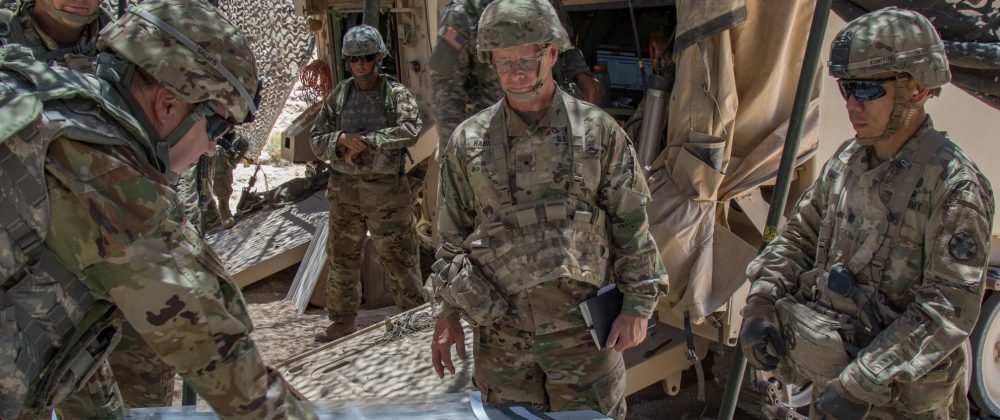Intel Center of Excellence deputy general visits National Training Center

FORT IRWIN, CA, UNITED STATES
06.05.2019
Story by Capt. Robert Taylor
Brig. Gen. Michael K. Hanifan, deputy commanding general, United States Army Intelligence Center of Excellence, visited with 116th Cavalry Brigade Combat Team’s intelligence officers and sections June 3-4, 2019, at the National Training Center in Fort Irwin, California, to see firsthand how the Army’s school for professional training of military intelligence prepares Soldiers to operate in a combat training center environment.
“I saw some sharp leader who knew what they were doing,” he said. “We need to equip them with the correct equipment and training.”
Hanifan said the school, located at Fort Huachuca, Arizona, has recently made three chances to its training requirements to provide Soldiers with effective and relevant training to be successful in their units. Those changes include placing an emphasis on getting away from creating only digital products and enhancing analog skills; shifting away from training on counterinsurgency in favor of decisive-engagement operations; and offering more training in a field environment outside of a classroom
“The changes in our focus has been very affective,” Hanifan said. “We’re headed in the right direction.”
Hanifan saw the effect of those changes on full display as the 116th CBCT’s intel sections worked to track the enemy on the battlefield using a combination of digital systems and analog products in the most realistic decisive-engagement field training environment the Army provides.
Throughout the simulated battle against opposing forces provided by the U.S. Army’s 11th Armored Cavalry Regiment, brigade and battalion intelligence personnel work together to provide commanders at all levels with a common operating picture of friendly and enemy forces’ locations and dispositions.
Information flows up and down echelons across the battlefield to answer commanders’ priority intelligence requirements and to detect, find and destroy enemy assets using available assets, including non-lethal targeting options.
Information collected is analyzed and fed through the brigade’s planning process and current operation cell. Information collected on the battlefield is imperative for commanders and their staffs.
“As elements move forward, we provide the commander with the best enemy picture possible so he can leverage the combat power he has available to make the best decisions possible,” said Capt. William Miller, 2nd Battalion, 116th Cavalry Regiment intelligence officer.
Hanifan, who also serves as the assistant adjutant general, Nevada Army National Guard, believes the National Training Center is the hardest intelligence battle Soldiers will fight, specifically designed to prepare Soldiers for operations in a combat zone. The training provides intel analyst the chance to test their skills against an actual force.
“It’s very realistic,” Spc. Anna Tinseth said. “It’s not notional. What you see on the map is what you’re going to see on the battlefield.”
Tinseth, a 35F intelligence analyst assigned to the Oregon Army National Guard’s 3-116th Cavalry Regiment, said the hands-on experience she is receiving during the 15-day field training exercise is increasing her understanding of her role in a battalion headquarters.
“I’m starting to understand how effective intelligence can be,” she said. “We can better prepare our line units to know what they are going to face on the battlefield.”
The 116th CBCT, one of the National Guard’s five armored brigade combat teams, is completing a National Training Center rotation at Fort Irwin, May 24 – June 20. NTC provides the brigade with the opportunity to train against a near-peer opposing force, challenging Soldiers’ tactical proficiencies and their technical expertise. More than 4,000 Soldiers, including Soldiers from Army National Guard units in 13 states, are participating in the exercise.
 Official Government Website
Official Government Website